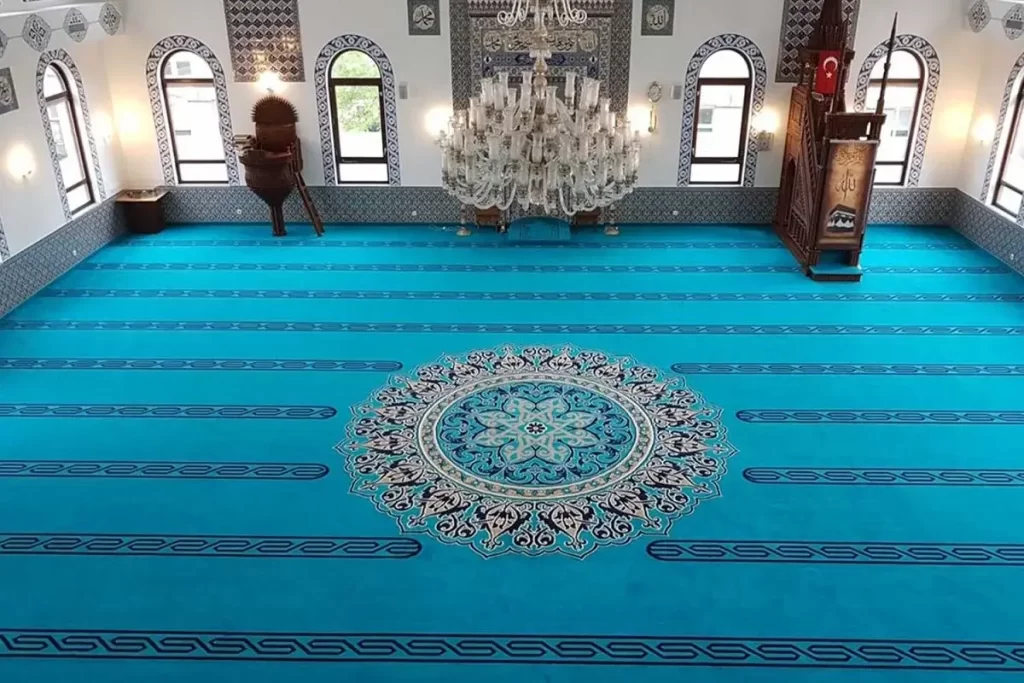Preserving Heritage: The Conservation and Care of Mosque Carpets

In the hallowed halls of mosques, where the echoes of prayers and the whispers of devotion reverberate, one often encounters a silent yet integral element that weaves together the spiritual and aesthetic tapestry of these sacred spaces—the mosque carpet. Beyond its role as a surface for prayer, the mosque carpet is a symbol of cultural identity, artistic expression, and centuries-old craftsmanship. As we delve into the intricate world of mosque carpets, it becomes imperative to recognize the significance of preserving this heritage.
The Conservation and Care of Mosque Carpets is a journey into the heart of these sacred textiles, exploring the artistry, history, and cultural importance that they embody. This exploration extends beyond mere aesthetics, encompassing the delicate balance between tradition and modernity, and the responsibility we bear in safeguarding the legacy woven into each fibre.
Join us as we unravel the threads that connect us to our rich cultural heritage, delving into the meticulous craftsmanship behind these carpets, understanding their historical context, and addressing the pressing need for conservation efforts. The preservation of mosque carpets is not just a matter of maintaining physical artefacts; it is a commitment to safeguarding the spiritual and cultural essence that transcends time. In this journey, we aim to shed light on the delicate dance between past and present, acknowledging the role of individuals and communities in ensuring that these carpets continue to grace the sacred spaces they call home.
The Importance of Mosque Carpet
The importance of mosque carpets extends far beyond their role as mere floor coverings. These intricately woven textiles hold a profound significance within the context of Islamic culture and worship. Here are key aspects that underscore the importance of mosque carpets:
Spiritual Atmosphere: Mosque carpets contribute significantly to the creation of a serene and focused environment for prayer. The soft, comfortable surface not only provides physical comfort during prostration but also plays a crucial role in cultivating a tranquil atmosphere conducive to spiritual contemplation.
Cultural Identity: The patterns, motifs, and designs found on mosque carpets often reflect the rich cultural heritage of the community. These carpets become visual representations of the shared history, values, and artistic traditions of a particular Islamic culture, serving as a source of identity for worshippers.
Symbolism and Sacred Geometry: Many mosque carpets feature intricate patterns and symbolic designs. These elements are often imbued with spiritual meanings, representing unity, harmony, and the divine. Sacred geometry, in particular, is a common feature, symbolising the order and perfection inherent in the Creator’s design.
Historical Connection: Mosque carpets have a historical legacy that spans centuries. Some carpets are considered priceless artefacts, offering a tangible connection to the past. Studying the evolution of mosque carpet designs provides insights into the cultural, artistic, and technological developments of different periods.
Artistic Expression: The creation of mosque carpets involves skilled craftsmanship, with artisans employing traditional weaving techniques passed down through generations. The carpets showcase a high level of artistry, demonstrating the beauty and creativity that can be achieved through meticulous attention to detail.
Community Bonding: The selection and care of mosque carpets often involve the community. Whether through communal efforts in fundraising to acquire quality carpets or in the maintenance and cleaning rituals, these activities foster a sense of communal responsibility and unity among worshippers.
Delineation of Sacred Space: Mosque carpets help define and delineate the sacred space within the mosque. The layout and design of the carpets guide worshippers during prayers, emphasising the direction of Mecca and contributing to the organised structure of the prayer space.
Factors to consider when selecting mosque carpets
Selecting the right mosque carpet involves careful consideration of various factors to ensure not only aesthetic appeal but also functionality and longevity. Here are key factors to keep in mind when choosing mosque carpets:
Material Quality: Consider the material used in the carpet’s construction. High-quality wool or a wool-synthetic blend is often preferred for its durability, resilience, and comfortable texture.
Durability and Longevity: Assess the durability of the carpet, especially in high-traffic areas. Look for carpets with a dense pile and sturdy construction to withstand regular use without significant wear and tear.
Design and Aesthetics: Choose a design that complements the mosque’s architectural style and overall interior. Consider traditional patterns, colours, and motifs that align with the cultural and artistic preferences of the community.
Size and Shape: Measure the prayer space accurately to select a carpet that fits seamlessly. Consider the layout of the mosque, including any alcoves or architectural features that may affect the carpet’s size and shape.
Maintenance and Cleaning: Opt for carpets that are easy to clean and maintain. Stain-resistant and anti-static treatments can contribute to the longevity of the carpet, and choosing colours that mask dirt and wear can reduce the visibility of any accumulated debris.
Budget Constraints: Establish a budget for the carpet selection process. Consider factors such as the size of the mosque, the quality of materials, and any additional features (such as intricate designs) that may influence the cost.
Cultural Significance: Select a carpet that aligns with the cultural and religious significance of the mosque. Consider incorporating symbols or motifs that hold specific meaning within the community or carry historical relevance.
Environmental Impact: Consider eco-friendly options and sustainable materials. Carpets made from natural fibers or those produced through environmentally conscious practices contribute to reducing the ecological footprint.
Comfort for Worshipers: Prioritise the comfort of worshippers during prayers. Choose a carpet with a suitable pile height and texture that facilitates ease of movement during prostration and prayer rituals.
Local Climate Considerations: Take into account the climate of the region. In areas with high humidity, for instance, breathable and moisture-resistant materials may be preferable to prevent mould and mildew.
Supplier Reputation: Research and choose reputable suppliers or manufacturers known for delivering quality mosque carpets. Reviews, testimonials, and past projects can provide insights into the reliability of the supplier.
Types of mosque carpet
Mosque carpets come in various types, each characterised by specific features, designs, and materials. Understanding these types allows mosque administrators and communities to choose carpets that align with their aesthetic preferences, cultural traditions, and practical needs. Here are some common types of mosque carpets:
Traditional Hand-Knotted Carpets: These carpets are crafted using traditional hand-knotting techniques, often by skilled artisans. They feature intricate patterns and designs, reflecting the rich cultural heritage of the community.
Tufted Carpets: Tufted carpets are made using a mechanised tufting process, which allows for faster production. While they may lack the handcrafted intricacies of traditional carpets, tufted carpets offer a more budget-friendly option.
Machine-Woven Carpets: Produced using automated machines, machine-woven carpets are known for their consistency and affordability. They often feature geometric patterns and are available in a wide range of designs and colours.
Axminster Carpets: Axminster carpets are machine-woven using a specific weaving technique that allows for intricate and detailed patterns. They are durable and commonly used in high-traffic areas within mosques.
Wilton Carpets: Similar to Axminster carpets, Wilton carpets are machine-woven but use a different weaving method. They are recognized for their durability and can be found in various designs suitable for mosque interiors.
Kilim Carpets: Kilim carpets originate from the Middle East and Central Asia. They are flat-woven, featuring vibrant colours and geometric patterns. Kilims are often lighter in weight compared to piled carpets.
Prayer Rugs: Specifically designed for personal prayer, prayer rugs are smaller in size and often feature a distinct mihrab (prayer niche) design that indicates the direction of Mecca. These rugs are convenient for individual use during daily prayers.
Sisal and Jute Carpets: Carpets made from natural fibres like sisal or jute offer an eco-friendly option. They are known for their durability and can provide a unique texture to the mosque interior.
Custom Designed Carpets: Many mosques opt for custom-designed carpets that reflect the unique identity and cultural heritage of the community. These carpets can incorporate specific motifs, colours, and symbols of significance.
Contemporary and Modern Carpets: Designed to complement modern mosque architecture, contemporary carpets often feature minimalist designs, bold colours, and innovative patterns that cater to a more modern aesthetic.
Iranian, Turkish, and Persian Carpets: Carpets from these regions often carry distinct regional styles and motifs. Iranian carpets, for example, may feature floral patterns, while Turkish carpets often showcase geometric designs.

Advantages and Disadvantages of Hotel Curtain
Advantages of Hotel Curtains:
Aesthetic Appeal: Hotel curtains contribute significantly to the overall aesthetic of the room, enhancing its visual appeal. The right choice of fabric, colour, and design can complement the interior décor and create a luxurious atmosphere.
Light Control: Curtains provide effective light control, allowing guests to adjust the level of natural light entering the room. This feature is crucial for ensuring a comfortable sleeping environment and maintaining privacy.
Temperature Regulation: Quality hotel curtains can contribute to temperature regulation by providing insulation. They help in keeping rooms cool in hot weather and retaining warmth during colder seasons, ultimately improving energy efficiency.
Privacy: Curtains offer a sense of privacy for guests, allowing them to control visibility from the outside. This is particularly important in urban hotel settings where rooms may face busy streets or neighbouring buildings.
Sound Insulation: Thick, well-designed curtains can contribute to sound insulation, reducing external noise and creating a quieter, more relaxing environment for guests.
Versatility in Design: Hotel curtains come in a variety of styles, designs, and fabrics, providing hoteliers with the flexibility to choose options that match the overall theme and branding of the establishment.
Customization: Hotels can opt for custom-designed curtains, allowing them to incorporate logos, patterns, or specific colour schemes that align with the brand identity.
Easy Maintenance:
Many hotel curtains are designed for easy maintenance, with fabrics that resist stains and can be cleaned efficiently. This is crucial for maintaining a clean and inviting atmosphere in guest rooms.
Disadvantages of Hotel Curtains: Cost:
High-quality, custom-designed curtains can be expensive, impacting the initial investment for a hotel. Additionally, maintenance costs for specialised fabrics may add to the overall expenditure.
Dust Accumulation: Curtains, especially those with heavy fabrics, can trap dust and allergens over time. Regular cleaning is essential to prevent the accumulation of dust, which may affect air quality.
Limited Lifespan: Curtains may have a limited lifespan due to factors such as fading from sunlight exposure or wear and tear. Replacement or frequent maintenance may be necessary to uphold the desired aesthetic.
Maintenance Challenges: Certain types of curtains may require professional cleaning, which can be a logistical challenge for hotels, especially if the cleaning process involves removing and reinstalling large and heavy drapes.
Occupancy and Wear: In high-occupancy hotels, curtains are subjected to more frequent use and handling, leading to faster wear and tear. This can result in a need for more frequent replacements or repairs.
Limited Light Options: While curtains offer light control, they may not provide the same versatility as other window coverings, such as blinds or shades, in terms of adjusting light levels throughout the day.
Bulkiness: Thick, luxurious curtains that contribute to effective insulation may also be bulky. This can limit the space around windows and may not be suitable for smaller rooms.

Conclusion
In conclusion, hotel curtains play a multifaceted role in shaping the guest experience and contributing to the overall ambiance of a hospitality establishment. The advantages they offer, ranging from aesthetic enhancement to light control and privacy, are substantial and align with the diverse needs of hotel guests. The ability to customise curtains further allows hotels to weave their brand identity into the very fabric of the guest experience, creating a unique and memorable stay.
However, it’s essential to acknowledge the associated challenges and disadvantages. The cost implications, maintenance requirements, and potential wear and tear underscore the importance of strategic decision-making in selecting and managing hotel curtains. Hoteliers must balance the desire for luxurious aesthetics with practical considerations, ensuring that the chosen curtains align not only with the brand image but also with the demands of a dynamic and often high-occupancy environment.



